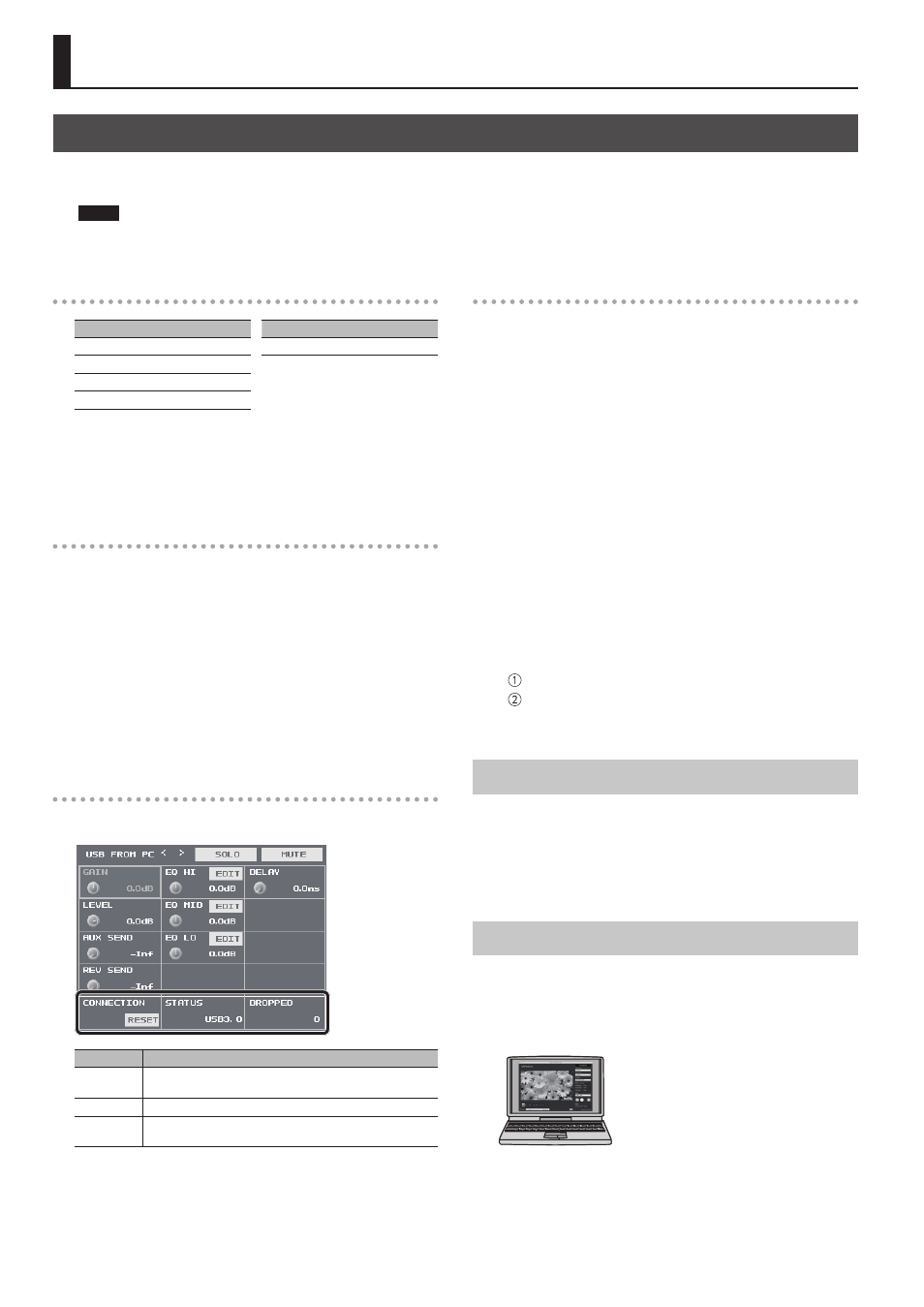Operations using a computer, Outputting streaming-use video/audio to a computer, Using the loopback feature – Roland VR-4HD HD AV Mixer User Manual
Page 36: Recording video on a computer, Net (p. 36, Supported operating systems, Making the connection to a computer, Checking the status of the usb connection, Outputting video/audio to the computer

36
Operations Using a Computer
Outputting Streaming-use Video/Audio to a Computer
You can connect a computer and output video and audio mixed on the VR-4HD to it. You can also input audio played back on the computer.
Using an Internet-connected computer and transfer software makes possible Internet drive transmission.
NOTE
5
For the video and audio signals from the VR-4HD to be viewed and heard correctly on the computer, software that supports USB video class and
USB audio class must be installed and set up on the computer.
Supported Operating Systems
Windows
Mac
Windows 7 Service Pack 1 and after
Mac OS X 10.9 or later
Windows 8
Windows 8.1
Windows 10
* Connection and operation of the VR-4HD with standard computers running
the operating systems described above have been verified, but connection
and operation with all computers satisfying such conditions is not assured.
Connection or operation may be impossible due to differences in setting
specifications or the usage environment that are specific to the equipment.
Making the Connection to a Computer
1.
Start the computer.
2.
Using a USB 3.0 cable, connect a USB 3.0 port on the
computer to the USB 3.0 port on the VR-4HD (p. 8).
3.
Turn on the power to the VR-4HD (p. 10).
When communication with the computer is established, the VR-4HD is
seen as a USB video device or USB audio device by the computer.
* When the VR-4HD has been connected to the computer for the
first time, the operating system’s standard driver is automatically
installed.
Checking the Status of the USB Connection
1.
Press the USB [SETUP] button to display the setup screen.
Item
Explanation
CONNECTION If a USB connection with the computer fails to be established or
video is corrupt, select
STATUS
This indicates a connection using either USB 2.0 or USB 3.0.
DROPPED
This is normally “0.” An increase in this value means that video
transmission is not fast enough.
2.
Press the USB [SETUP] button to quit the setup screen.
Outputting Video/Audio to the Computer
1.
Operate the VR-4HD to prepare the video or audio to
Output to the computer.
2.
On the computer, confirm the input from the VR-4HD.
Start a program that supports USB video class or audio class, and
check the video or audio input from the VR-4HD.
If necessary, make the following settings on the VR-4HD.
5
Use the [TO PC] knob to adjust the volume level of USB output audio
(p. 27).
5
Adjust the volume balance of the input audio (p. 27).
5
Adjust the volume level of the main output audio (p. 27).
5
Align the output timing of the video and audio (p. 35).
For USB output audio only, you can delay output individually.
The USB [SETUP] button
g
at the USB TO PC page, use
adjust the delay time for audio.
5
Make the setting for the audio bus assigned to the USB 3.0 port
5
Specify whether either of the following is set as the video output via
Main output video
Four-way split screen using input video (channels 1– 4)
Using the Loopback Feature
You can take audio played back by a program on the computer, mix it
with other audio input into the VR-4HD, and return the result back to
the computer (Loopback feature).
This lets you do things like adding narration to played-back music,
then using computer software to record or stream it.
Recording Video on a Computer
You can use the dedicated Video Capture for VR software to capture
(record) video and audio output from the VR-4HD on a computer
connected via USB.
For more information about operation methods, refer to the owner’s
manual included with Video Capture for VR.
Video Capture for VR can be downloaded from the following Roland
website.
http://proav.roland.com/
